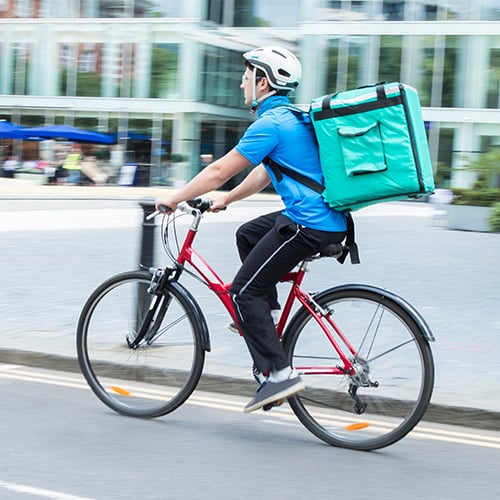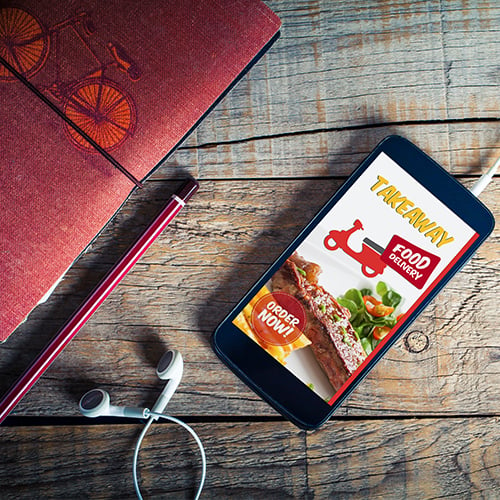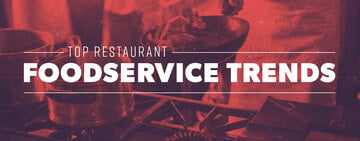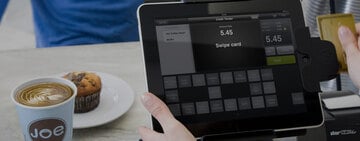What Is a Ghost Kitchen?
The term ghost kitchen categorizes foodservice businesses without dining areas that offer delivery and, occasionally, takeout. Sometimes referred to as ghost restaurants, virtual kitchens, or satellite kitchens, ghost kitchens use third-party delivery services to receive orders and get meals to customers.
The ghost kitchen business model helped restaurateurs get through the hard times caused by the coronavirus pandemic. They remain relevant in the post-pandemic foodservice landscape because they allow operators to meet new consumer expectations, reduce operational costs, and provide easy menu expansion.
Use these links to jump to the answer of your most pressing ghost kitchen questions:
How Do Ghost Kitchens Work?

Typically, ghost kitchens prepare meals when they’re ordered in a commercial kitchen that doesn’t have a dining area. Setting up a delivery service is costly, so most ghost kitchens use third-party delivery services.
Since they can’t rely on walk-in customers, ghost kitchens create strong social media presences and invest in digital advertising tactics. Virtual restaurants are not home chefs selling their wares online, nor are they distributors of prepackaged foods. They operate on the same scale as sit-down restaurants and craft unique menus.
Most virtual restaurants operate out of a commissary kitchen. A commissary kitchen is a complete, commercial kitchen space that is available for rent. While you can share a commissary kitchen, most virtual restaurants rent private commissaries because they need the space at different times than other typical commissary users. For example, caterers and mobile kitchen operators need the commissary to prep meals in advance, and dark kitchens need it during traditional restaurant hours.
Ghost Kitchen Profit Margin
The digital ordering and delivery sector has grown 300% faster than dine-in traffic since 2014, indicating that ghost kitchens are an extremely profitable business venture. Ghost kitchens are a particularly profitable alternative to owning a dine in restaurant in high-rent areas saturated with eateries. Virtual restaurants save money on startup costs, building upkeep, and front-of-house staff. The biggest threat to a cloud kitchen’s profitability are the steep fees imposed by third-party delivery apps, which can extract between 15% to 30% of each order.
Types of Ghost Kitchens
Just like brick-and-mortar restaurants, ghost kitchens vary in scope and dining style. We explain six different virtual restaurant business models, so you can decide which fits your goals and financial means.
1. Independent Ghost Kitchen

An independent ghost kitchen prepares a single menu to order in a kitchen without a storefront. Most independent ghost kitchens partner with multiple third-party delivery apps. Independent ghost kitchens leave prepared orders for the partnered driver to pick up at the front desk. They are reliant on third-party apps to receive orders and do not own their customers’ data. Not owning customer data means you can’t interact with or retain customers without your partnered delivery services.
2. Multi Brand Ghost Kitchen
Multi brand ghost kitchens receive orders and make deliveries in the same way as single brand ghost kitchens. The difference between multi and single brand ghost kitchens is their scale. A multi brand company will use a single kitchen space to prepare multiple virtual restaurant menus.
Preparing multiple virtual dining concepts increases your total orders and broadens your customer reach. While consumers are wary of physical restaurants claiming to have both the best sushi and spaghetti in town, the anonymity of satellite kitchens allows you to prepare vastly different menus in the same space without raising skepticism.
3. Operator Managed Ghost Kitchen
When brick-and-mortar eateries prepare a virtual restaurant’s menu in their kitchen space, they're called operator managed ghost kitchens or virtual franchises. They won’t list the virtual concept on their physical menu. Customers place their orders through third-party delivery apps or the virtual concept’s central food order website/mobile app.
When operators allow virtual restaurant patrons to pick up their orders, they capture customers who typically shy away from ghost kitchens to avoid delivery fees. Integrating a virtual franchise is especially advantageous for bakery and cafe owners who don’t rely on their kitchen during the day. Many grocery stores, including Walmart and Kroger, are adopting the operator managed ghost kitchen business model as well.
4. Mid Ground Ghost Kitchen
Mid ground ghost kitchens prepare orders in a kitchen with a small storefront where customers can pick up their order if they prefer. Many mid ground satellite kitchens are adopting a drive through only, off-premise dining business model, but a simple pickup window suffices. While having a pickup area may cost you a bit more in rent, you’re still likely to take home more of your profits, because delivery services can take up to 30% of each order.
People can place their orders directly through mid-ground ghost kitchens, providing operators with ongoing access to their customers should they change delivery services. Additionally, mid ground ghost kitchens have a wider clientele base since many consumers want the convenience of eating at home but don’t want to pay a delivery fee.
5. Brand Owned Ghost Kitchen
Brand owned ghost kitchens sign on with a single third-party delivery service and agree to only take orders through their platform. Increasingly, third-party delivery services are pushing for brand ownership, because it gives them a monopoly on the delivery market and control over the businesses that use them.
Since it is the third-party delivery company, not the ghost kitchen, who owns customer data and controls customer access, businesses that sign brand owned deals are at the mercy of the third-party delivery service they use. The delivery service can continually raise fees, because the virtual restaurant can’t make a change without losing all their customers and having to start over.
Being locked into one delivery service has its significant risks, but it also comes with rewards. If your ghost kitchen is brand owned, the delivery app will want you to succeed and will often push more business your way. You will probably appear higher on the app’s search results page and receive other advertising aids.
6. Virtual Spin-Off Ghost Kitchens
To capitalize on popularity, some brands create ghost kitchen concepts based on sections of their menu. By offering a limited menu featuring delivery-friendly concepts, these brands are able to test out new markets without having to establish a brick-and-mortar store. Popular examples of this type of ghost kitchen include Chicken n’ Biscuits by Cracker Barrel and Just Wings by Chilis.
Back to TopPros and Cons of Ghost Kitchens
As with any type of business, ghost kitchens have pros and cons that are specific to them. Depending on your financial background, staffing preferences, and business model, you may find them beneficial or difficult to succeed with. We'll investigate the pros and cons of ghost restaurants below:
Pros of Ghost Restaurants

Here are some advantages of operating a ghost restaurant over a traditional eatery:
- Concept Flexibility: Being digitally based means you can change your restaurant concept without having to update signage or decor.
- Adjustable Menu: If want to experiment with a new dish, an ingredient becomes too expensive, or produce goes out of season, you can swap out bill of fare items without having to reprint your menu.
- Smaller Investment: Many expensive aspects of operating an on-premise dining establishment (such as decor, signage, dinnerware, and seating) don’t apply to virtual restaurants.
- Reduced Staff: Satellite kitchens eliminate front-of-house staff, allowing operators to focus on hiring and keeping quality chefs and investing in premium ingredients and appliances.
Cons of Ghost Restaurants
The major disadvantages of operating a ghost kitchen are the costs and challenges of setting up a delivery service that is financially sustainable. Creating an in-house delivery system is costly and complex, so most satellite kitchens rely on third-party delivery services. Not only do third-party deliver services take between 15 to 30 percent of each order, but they also own your customers’ data. Because customers place their orders through third-party apps, you do not own your customers; they do. If your third-party delivery app becomes too costly for you to use, you’ll lose the customer base you built through them.
Additionally, third-party apps function like search engines and control which restaurants appear first when people search for food. To show up on their first search page, you must pay the third-party delivery service an advertising fee. Delivery services give top priority to the restaurants that agree to use them exclusively, putting pressure on restaurants to lock themselves into one delivery partner.
Overcoming Third-Party Delivery Challenges
The best thing you can do as a ghost kitchen operator is secure access to your customers’ data. Include flyers in customers’ orders encouraging them to follow you on social media and sign up for rewards programs. You can also create giveaways that require customers to input their email address to enter.
Ghost Kitchen vs Traditional Restaurant
Use these fast facts comparing ghost kitchens and traditional restaurants to determine which is right for you.
- Average Ghost Kitchen Size - 200 to 300 square feet
- Average Traditional Restaurant Size - 2000 square feet
- Average Ghost Kitchen Staff Size - 4
- Average Traditional Restaurant Staff Size - 25+
- Average Time to Launch a Ghost Kitchen - 1 Month
- Average Time to Launch a Traditional Restaurant - 52 weeks
- Average Ghost Kitchen Startup Investment - $30,000
- Average Traditional Restaurant Startup Investment - $1 million
- Average Time for a Ghost Kitchen to Breakeven - 6 Months
- Average Time for a Traditional Restaurant to Breakeven - 5 years
According to Reportlinker, the online food delivery services global market will reach $192.16 billion by 2025. Ghost kitchens align themselves with the times and meet the growing demand for food delivery. Urban residents and busy, young consumers were the first to accept cloud kitchens. In normal circumstances, it may have taken years for suburban and older consumers to embrace virtual restaurants. However, the coronavirus pandemic sped up the adoption life cycle, providing ghost kitchens with universal acceptance overnight.



